Black History: The Civil Rights Era
The Civil Rights movement was an organized movement led by black Americans that occurred after World War Two until the late 1960s to end legal discrimination based on race. The movement saw non-violent protests challenge discrimination in the political arenas but also pushed for desegregation in sports, film, television, and popular music.
Click here to see more posts in this category.
Black Americans had to ‘fight’ for their right to equality. In the 1950s a Baptist preacher named Martin Luther King became the leader of the Civil Rights Movement. He believed that peaceful protest was the way forward.

The Civil Rights Movement: The Struggle for Equality
(See Main Article: The Civil Rights Movement: The Struggle for Equality)
The Civil Rights movement was an organized movement led by black Americans that occurred after World War Two until the late 1960s to end legal discrimination based on race. The movement saw non-violent protests challenge discrimination in the political arenas but also pushed for desegregation in sports, film, television, and popular music.
Like they had following the Great War, black soldiers returned from WWII as champions of democracy to a society that treated them as second-class citizens. That older generation of “new negroes,” the first to come of age after both slavery and Plessy v. Ferguson, the famous case that legalized racial segregation in 1896, had pushed a civil rights agenda during the 1920s with minimal success. The Great Depression had hit black Americans especially hard, and little gain had been made since the New Deal. Despite the Great Migration of 1910-1940, most blacks still lived in the South under Jim Crow, where state laws kept them segregated in all areas of public life—parks, restaurants, theaters, sporting events, cemeteries, beaches, hospitals, public transportation, and in the public schools. Even blood for transfusions was segregated. Blacks had made no real progress in political power either. At the beginning of WWII only 2 percent of eligible southern African Americans were registered to vote.
But WWII had brought about irrevocable change. Over a million black soldiers had served in uniform. The share of defense jobs held by blacks had increased from 3 to 8 percent. Nearly half a million people belonged to the NAACP. In 1944, NAACP lawyer Thurgood Marshall argued before the Supreme Court that all-white primaries in the South violated his black client’s 14th Amendment right to equal protection. The case, known as Smith v. Allwright, was an 8-1 victory. A new sense of mission was forged as black Americans, joined by some white allies, began to express resistance to passive acceptance of the pre-war status quo. Black soldiers led the way as the number of black registered voters in the South increased to 12 percent by 1947.
These efforts at democratic expression met with stiff resistance by southern whites. When Medgar Evers and four others went to vote in Mississippi, they were driven away at gunpoint. White supremacist Eugene Talmadge won the Georgia governorship in 1946 by promising to defy Smith v. Allwright (he died before taking office). Several blacks who attempted to vote in Georgia were murdered, and when one of the victim’s wives recognized one of the murderers, she was murdered too. In rural Mississippi, war veteran Etoy Fletcher tried to register to vote and was told by the registrar, “Niggers are not allowed to vote in Rankin County, and if you don’t want to get into serious trouble, get out of this building.” Fletcher was then grabbed by 4 whites at the local bus station, driven into the woods, and beaten.
The Columbia Race Riot, 1946
In Columbia Tennessee, on February 25, 1946, a dispute erupted between James Stephenson, a black Navy veteran, and a white shopkeeper, who was threatening violence against Stephenson’s mother over a disputed radio repair bill. The subsequent scuffle resulted in the clerk crashing through a store window. The Stephensons were arrested for disturbing the peace, pleaded guilty, and paid a fifty dollar fine. Later in the day, a new arrest warrant was issued for Stephenson on the charge of assault with the intent to commit murder. Later that night several police officers were wounded in the segregated black business section of town known as Mink Slide. The next day, White police and citizens swarmed through the district, violating civil rights, illegally confiscating weapons, and arresting a hundred blacks. Two days later, Columbia policemen killed two black prisoners in custody. Thurgood Marshall flew in from Nashville to mount a legal defense. Several blacks were convicted for the shooting and wounding of white officers. A federal grand jury was convened to investigate charges of police misconduct, but the all-white jury absolved them of any wrong doing. On the way out of town, Thurgood Marshall was arrested on trumped up drinking and driving charges. After a long and anxious drive though the countryside, apparently intended as a warning, he was set free.
Some of the protests of the Civil Rights movement are detailed below:
1954 Oliver Brown v. Board of Education of Topeka, Kansas
(See Main Article: Brown v. Board Of Education of Topeka)
“The NAACP Leader Who Passed As White, Infiltrated Lynching Rings, Architected ‘Brown v. Board of Education’, and Ended His Life in Scandal”
For the full “History Unplugged” podcast, click here!
In the 1950s, school segregation was widely accepted throughout the United States and was a requirement of law in most southern states.
In 1952, the Supreme Court heard a number of school-segregation cases, including Brown v. Board of Education of Topeka, Kansas. In 1954 the court decreed that segregation was unconstitutional.
Brown v. Board Of Education of Topeka was a landmark decision of the U.S. Supreme Court in which the Court ruled that American state laws establishing racial segregation in public schools are unconstitutional, even if the segregated schools are otherwise equal in quality.
Handed down on May 17, 1954, the Court’s unanimous (9–0) decision stated that “separate educational facilities are inherently unequal,” and therefore violate the Equal Protection Clause of the Fourteenth Amendment of the U.S. Constitution. However, the decision’s 14 pages did not spell out any sort of method for ending racial segregation in schools, and the Court’s second decision in Brown II (349 U.S. 294 (1955)) only ordered states to desegregate “with all deliberate speed.”
Impact of Brown vs Board of Education
(See Main Article: Impact of Brown vs Board of Education)
Scholarly opinion has even begun to suggest that the Brown decision was not necessary in order to bring about desegregation. According to Paul Craig Roberts and Lawrence Stratton:
A July 1944 survey of college students found that 68 percent agreed that “our postwar policy should be to end discrimination against the Negro in schools, colleges and universities.” Georgia’s progressive governor, Ellis G. Arnall, accomplished the repeal of the poll tax in 1945 and thereby knocked down a barrier to black voting. Jackie Robinson broke the color line in baseball in 1947, and black entertainers such as Lena Horne found increased access to Hollywood and Broadway. In response to the Truman civil rights committee’s report, ordinary people, such as citizens of Montclair, New Jersey, took community inventories to expose and challenge local segregation. The Red Cross eliminated the racial designation of blood donors in 1950. Oklahoma high school students ignored traditional prejudices and elected a seventeen-year-old black to lead the state’s Hi-Y clubs in January 1952.
Writing in the Journal of American History, Michael Klarman provides further evidence of such trends. He discusses the cases of blacks in the 1940s who won local political offices, often with substantial white support. He cites polling data showing increasingly favorable Southern attitudes toward integrated transportation facilities and other forms of desegregation. For these reasons and more, Klarman could conclude that “Brown was not necessary as an impetus to challenge the racial status quo.”
What Did Martin Luther King Do?
(See Main Article: What Did Martin Luther King Do?)
Martin Luther King, Jr. was an activist and pastor who promoted and organized non-violent protests. He played a pivotal role in advancing civil rights in America and has won a Nobel Peace Prize for his efforts to fight racial inequality in a non-violent matter.
Martin Luther King’s Activities
- Brought publicity to major civil rights efforts
- Promoted non-violence during protests
- Contributed in founding the African-American Civil Rights Movement
- Leader in the Montgomery Bus Boycott of 1955
- Was one of the founders of the South Christian Leadership Conference and its first president
- Fought against segregation in Albany, Georgia
- Helped organize non-violent protest actions in Birmingham Alabama
- Was one of the organizers of the March of Washington in 1963 where he delivered his “I Have a Dream” speech
- Helped organize the Selma to Montgomery marches in 1965
- Worked on segregated housing in Chicago
- Fought against poverty in America
- Fought against America’s involvement in the Vietnam War
- Planned the “Poor People’s Campaign,” a national occupation of Washington D.C., but was assassinated before this could happen.
Martin Luther King Jr. And The Founding Of SCLC
(See Main Article: Martin Luther King Jr. And The Founding Of SCLC)
the Southern Christian Leadership Conference (SCLC) was created on January 10-11, 1957, when sixty black ministers and civil rights leaders met in Atlanta, Georgia in an effort to replicate the successful strategy and tactics of the recently concluded Montgomery, Alabama bus boycott. Rev. Martin Luther King Jr. was chosen as the first president of this new group dedicated to abolishing legalized segregation and ending the disfranchisement of black southerners in a non-violent manner.
SCLC.com reports that the boycott was carried out by the newly established Montgomery Improvement Association (MIA). Martin Luther King Jr. served as President and Ralph David Abernathy served as Program Director. It was one of history’s most dramatic and massive nonviolent protests, stunning the nation and the world. The boycott was also a signal to Black America to begin a new phase of the long struggle, a phase that came to be known as the modern civil rights movement.
As bus boycotts spread across the South, leaders of the MIA and other protest groups met in Atlanta on January 10 – 11, 1957, to form a regional organization and coordinate protest activities across the South. Despite a bombing of the home and church of Ralph David Abernathy during the Atlanta meeting, 60 persons from 10 states assembled and announced the founding of the Southern Leadership Conference on Transportation and Nonviolent Integration.
They issued a document declaring that civil rights are essential to democracy, that segregation must end, and that all Black people should reject segregation absolutely and nonviolently.
Further organizing was done at a meeting in New Orleans, Louisiana on February 14, 1957. The organization shortened its name to Southern Leadership Conference, established an Executive Board of Directors, and elected officers, including Dr. Martin Luther King Jr. as President, Dr. Ralph David Abernathy as Financial Secretary-Treasurer, Rev. C. K. Steele of Tallahassee, Florida as Vice President, Rev. T. J. Jemison of Baton Rouge, Louisiana as Secretary, and Attorney I. M. Augustine of New Orleans, Louisiana as General Counsel.
Black Celebrities of the Civil Rights Movement
(See Main Article: Black Celebrities of the Civil Rights Movement)
“Jackie Robinson, The Negro League, and Civil Rights”
For the full “History Unplugged” podcast, click here!
The postwar years were the era of the integration of America’s professional sports. Jackie Robinson, Althea Gibson, Bill Willis and others became household names. Beyond sports, black movie stars made had significant cultural milestones during the decade, while television appearances remained typed and relatively rare. Music, particularly rock and roll, had a unifying influence on the youth culture of America. The postwar era coincided with congressional anti-Communism investigations, and black writers and performers were investigated for having expressed sympathy for communism, an ideology that claimed it eschewed racism.
1955 Montgomery Bus Boycott
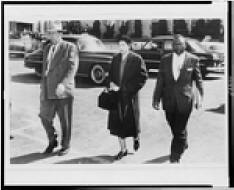
Rosa Parks, a 43 year old black seamstress, was arrested in Montgomery, Alabama, on 5th December 1955 for refusing to give up her bus seat to a white man. The Montgomery Bus rules stated that white people boarding its buses should fill the bus by occupying seats from the front backwards. Coloured people should fill the bus by occupying the seats from the back forwards. If the bus became full additional coloured people boarding the bus would stand but if additional white people boarded the bus coloured people would be expected to give up their seats and stand. Civil Rights leaders including Dr. Martin Luther King, organized the Montgomery Bus Boycott specifically in protest against Parks’ arrest but also as a protest against the segregation practices used by the bus company.
Parks was found guilty by a court on 5th December and fined but she appealed the court’s decision. Meanwhile the Montgomery Bus boycott was being put into place. Negroes and others who supported equality agreed not to use the buses, a move which would deprive the bus company of 65% of its income.
Although Martin Luther King was fined $500 for interfering with the running of businesses, the protest was successful and on 4th June 1956 the Supreme Court decided, based on the outcome of recent school segregation cases, that bus segregation violated the United States constitution.
1957 Desegregation at Little Rock, Arkansas
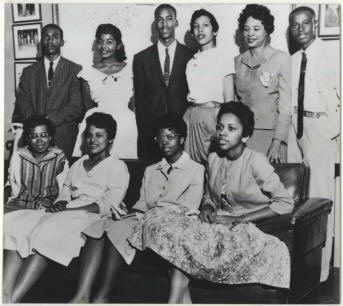
The Little Rock School Board approved a desegregation programme and nine coloured students were enrolled at the school. The Little Rock Nine (left) Ernest Green, Elizabeth Eckford, Jefferson Thomas, Terrence Watts, Carlotta Walls La Nier, Minnijean Brown, Gloria Ray Karlmark, Thelma Mothershed, Melba Pattillo Beals were to begin their studies in September 1957.
On 4th September the nine students duly arrived at the school but found their way barred by anti-desegregation protestors. Arkansas governor, Orval Faubus, had ordered the Arkansas National Guard to reinforce the protest line. The National Guard remained stationed outside the school until 20th September when the courts ordered Faubus to remove them.
On September 23rd the nine students returned to the school and although they were shouted at and jeered by the angry crowd of white protestors they were able to enter the school. However, fearing for their safety the police sent them home before the end of the day.
President Eisenhower intervened at this point and ordered the 101st Airborne Division of the US Army to Little Rock where they were to ensure that the nine students were able to enter and leave the school in safety. He also federalised the National Guard so that they could no longer be deployed by Faubus. The 101st Airborne remained in Little Rock until November 1957.
In Spring 1958 Minnijean Brown was suspended for her acts of retaliation against white taunts and abuse. The other eight remained at school despite the abuse and taunts and all eight graduated.
1960 Sit-in Campaigns
(See Main Article: Black Peoples of America – Civil Rights)
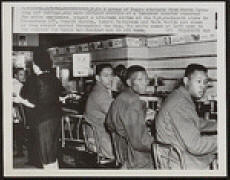
After having been refused service at the lunch counter of a Woolworth’s in Greensboro, North Carolina, Joseph McNeill, a Negro college student, returned the next day with three classmates to sit at the counter until they were served.
They were not served. The four students returned to the lunch counter each day.
When an article in the New York Times drew attention to the students’ protest, they were joined by more students, both black and white, and students across the nation were inspired to launch similar protests.
1961 Freedom Rides
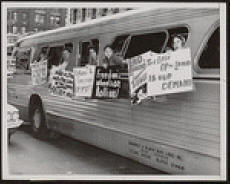
The Freedom Riders originally consisted of a group of 13 activists who fought for civil rights and against the segregation in interstate bus terminals in the American South. The Congress of Racial Equality originally recruited the group of Freedom Riders and they departed from Washington D.C., attempting to make use of “whites-only” (and vice versa) facilities along the route towards the deep South. Although the Freedom riders were met with very violent treatment from white protesters en route, they managed to gain a lot of international attention. The group grew and hundreds more Freedom Riders joined in their cause, with similar protests. The Interstate Commerce Commission prohibited segregation in train- and bus stations across the country in September, 1961.
The first Freedom Ride started on May 4, 1961. A group of 13 riders, of which six white and seven black, left Washington DC on two buses (Greyhound and Trailways). They were planning to drive through the south, ending the route in New Orléans. Their tactics were to have at least one black and one white person in adjoining seats, one black person in the front, “whites only” sets and the rest on seats throughout the bus. One rider would stick to the rules in order to avoid arrest, so he can contact CORE to organize bail. They would also try to use the “wrong” restrooms at stops on the way. The group was however met with heavy resistance from Ku Klux Klansmen who attacked one of the buses on May 14. They slashed its tires, firebombed it and kept the doors shut to try to burn the riders to death. Luckily the riders managed to escape the bus when either the fuel tank exploded or shots went off, but they were caught up with and badly beaten. The riders were hospitalized and attempted to continue their journey, but after further violence they were forced to cut the trip short. This, however didn’t stop other freedom riders to follow their example.
1962 University of Mississippi Riot
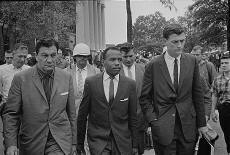 President Kennedy ordered Federal Marshals to escort James Meredith, the first black student to enrol at the University of Mississippi, to campus. A riot broke out and before the National Guard could arrive to reinforce the marshals, two students were killed.
President Kennedy ordered Federal Marshals to escort James Meredith, the first black student to enrol at the University of Mississippi, to campus. A riot broke out and before the National Guard could arrive to reinforce the marshals, two students were killed.
1963 Birmingham
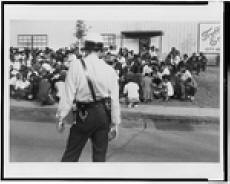
Birmingham, Alabama was one of the most segregated cities in the 1960s. Black men and women held sit-ins at lunch counters where they were refused service, and “kneel-ins” on church steps where they were denied entrance.
Hundreds of demonstrators were fined and imprisoned. In 1963, Dr. King, the Reverend Abernathy and the Reverend Shuttlesworth led a protest march in Birmingham where they were arrested by policemen with dogs. The three ministers were taken to Southside Jail.
The Early Stages of the Civil Rights Movement: The Postwar Era (1946-1953)
(See Main Article: The Early Stages of the Civil Rights Movement: The Postwar Era (1946-1953)

The Isaac Woodard Story
In February 1946 a black soldier named Isaac Woodard was on his way home in South Carolina, having just been mustered out of the Army. At a stop along the way, Woodard had a verbal altercation with the driver over permission to use the restroom. After using the restroom, he returned to his seat without incident. At Batesburg, the next stop, the diver contacted Sheriff Linwood Shull, who forcibly removed Woodard from the bus. After demanding to see his discharge papers, a group of officers took Woodard, still in uniform, to a nearby alleyway and beat him with nightsticks. He was then taken to jail and arrested for disorderly conduct. Overnight, more beatings and jabs in the face with a nightstick resulted in both of Woodard’s eyes being ruptured, and the onset of partial amnesia. The next day, Woodard was brought before a local judge, found guilty, and fined fifty dollars. Not knowing where he was and still suffering from amnesia, Woodard ended up in a nearby hospital receiving substandard care. It took his family ten days to find him. The story eventually reached the ears of President Truman, who angrily demanded that the Attorney General take action. The resulting trial of Sheriff Shull, who admitted he had blinded Woodard, was a shameful failure, resulting in the courtroom breaking into applause when Shull was acquitted after 30 minutes of deliberation [Read lyrics to the song, “The Blinding of Isaac Woodard,” by Woody Guthrie].
President Truman’s Response
“Dewey Defeats Truman: The 1948 Election and the Battle for America’s Soul”
For the full “History Unplugged” podcast, click here!
The postwar era was characterized by a total lack of response to the needs of Black Americans from the legislative branch of government. President Truman, however, was angry over the treatment of black Americans, particularly war veterans, and although his commitment to civil rights was tempered somewhat by political necessity, several milestones were achieved during his administration. On December 5, 1946, Truman established by executive order the President’s Committee on Civil Rights. The committee was instructed to investigate the status of civil rights in the United States and propose measures to strengthen and protect the civil rights of American citizens. In the meantime, Truman became the first president to address the NAACP, at the Lincoln Memorial on July 29, 1947.
In December the committee produced a 178 page report. Its recommendations included improving the existing civil rights laws; establishing a permanent Civil Rights Commission, a Joint Congressional Committee on Civil Rights, and a Civil Rights Division in the Department of Justice; development of federal protection from lynching; creation of a Fair Employment Practices Commission (FEPC); and abolishment of poll taxes, among other measures. On February 2, 1948, Truman became the first president to send a Special Message to Congress on Civil Rights, in which he requested that Congress implement the committee’s recommendations.
On July 26, 1948, President Truman issued Executive Order 9981, banning segregation of the armed forces. Although this was done over the protests of senior military officials, the Korean War soon necessitated the integration of combat units, without the predicted loss of combat effectiveness. In fact, by the end of the Korean War, the Eisenhower administration was promoting the integrated military as an example of American freedom that served to deny communist propaganda which claimed that American-style democracy was institutionally racist.
President Truman, despite his call for aggressive federal action on the issue, gave his backing to party platform language that duplicated the 1944 plank. Liberal Democrats insisted on the insertion of a “minority plank” to the party platform that would commit the Democratic Party to calling for an end to segregation in public schools, legislation against lynching, and an end to job discrimination based on race. Truman’s aides lobbied to avoid forcing the issue on the Convention floor, but the Mayor of Minneapolis, Hubert H. Humphrey, defied them. Humphrey passionately told the Convention: “To those who say, my friends, to those who say, that we are rushing this issue of civil rights, I say to them we are 172 years late! To those who say, this civil rights program is an infringement on states’ rights, I say this: the time has arrived in America for the Democratic Party to get out of the shadow of states’ rights and walk forthrightly into the bright sunshine of human rights!” Humphrey and his allies succeeded in getting their “minority plank” adopted. Consequently, the South revolted. The Mississippi and half of the Alabama delegation, 35 in all, stormed out of the hall. Many Southern Democrats subsequently formed the Dixiecrat Party, and nominated South Carolina’s Strom Thurmond. The Dixiecrats called for States Rights, Social Conservatism, and continued racial segregation. The goal of the Dixiecrats was to see the Democrats suffer such a defeat that they would forever abandon the civil rights cause. What they hadn’t anticipated, however, was the surge of black votes for Truman in the North that allowed the President to win a surprise victory over Republican Thomas E. Dewey. Humphrey was elected to the Senate.
1950-1953
“Eisenhower’s Interstates: The Modern-Day Roman Roads”
For the full “History Unplugged” podcast, click here!
The actions by President Truman, though important, were largely symbolic without congressional legislative action, and they failed to have an impact on the day-to-day lives of black Americans. The president failed to use the power given to him by the 14th and 15th amendments to execute laws strong enough to combat discrimination. Especially in the critical arena of voting rights, black Americans in the South continued to be denied. In Florida in 1948, a black voting rights activist’s home was bombed, crippling one of his children. D.V. Carter was severely beaten in Montgomery County, Georgia, after ignoring warnings from the KKK to cease voter registration efforts there. Army veteran Isaac Nixon, whom Carter had persuaded to vote, was murdered in 1948 for exercising his voter rights. Two whites were charged in the murder but where acquitted by an all-white jury. And justice continued to be denied African Americans when accused of other crimes against white society. In Albany Georgia, sharecropper Rosa Lee Ingram and her two sons were sentenced to death in the self-defense killing of an armed white farmer who had attacked Mrs. Ingram with a rifle butt while she and her sons were working in the field.
In May 8, 1951, Willie McGee was executed for raping a white housewife in Laurel, Mississippi; even though the evidence suggested that the charges were brought out of fear that their consensual affair was about to become public knowledge. Despite the attention his case received from such notable personalities as William Faulkner and Albert Einstein, President Truman resisted calls to pardon McGee, and he was executed by electric chair. That same year, the Florida home of Harry T. Moore, founder of that state’s Progressive Voters’ League, was bombed on Christmas night, killing Moore and his wife.
And these civil rights violations were not confined strictly to the south. In 1948, six African-American defendants were convicted by an all-white jury of the murder of an elderly white shopkeeper in Trenton, New Jersey. The victim, William Horner, had been hit over the head with a soda bottle in his second-hand furniture store. Mrs. Horner could not agree on how many men were actually involved, nor could she identify the “Trenton Six,” as they came to be known, as the men in her store. The men were all arrested without warrants, were held without being allowed access to legal representation, and were questioned for as long as four days before being brought before a judge. As a result, 5 of the 6 were coerced into signing confessions. No forensic evidence was introduced in court, all of them subsequently repudiated their false confessions, and all six were able to provide alibis. Nevertheless, all were convicted and sentenced to death. On appeal, the Trenton Six received high profile legal counsel from the Communist Party USA (who championed civil rights causes for ideological reasons), and the NAACP, including Thurgood Marshall. Two of the six were ultimately declared guilty, while the remaining four were found not guilty.
In 1952, the country elected as its President, the former Supreme Allied Commander of WWII, Dwight D. Eisenhower. The Republican showed no real signs of interest in the race issue. But the forces of change had been set in motion. When real change came, it would arrive from both ends of the social strata. It would be championed from the churches and tenant farms of Georgia, and from the Supreme Court of the United States, where former California Governor Earl Warren would shock traditionalists and President Eisenhower, who had nominated him, by rallying the court for the most activist era of judicial decisions in that body’s history.
Cite This Article
"Civil Rights Era: The Struggle For Equality" History on the Net© 2000-2024, Salem Media.
July 27, 2024 <https://www.historyonthenet.com/civil-rights-era>
More Citation Information.





